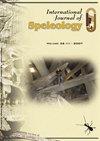Paleokarst coastal caves at Torricelle Hills (Lessini Mountains, Venetian Prealps, Italy)
IF 1.3
4区 地球科学
Q3 GEOSCIENCES, MULTIDISCIPLINARY
引用次数: 0
Abstract
This paper describes a set of paleokarst caves at Torricelle Hills near Verona (Southern Alps, Italy.) At this locality, erosional surfaces and paleokarst cavities show that sedimentation of late Paleogene neritic limestones was interrupted by subaerial exposure. Karst features developed during a phase of marine regression that started after the early Oligocene and ended in the mid Miocene. These caves were originally completely filled by iron oxides- and hydrated oxides-rich paleosol sediments (ochre) that, for centuries, have been mined for pigments. Mining activity emptied the caves, leaving the voids and related shapes mostly intact; as a result, the original morphologies have been exhumed, making these caves a rare example of explorable paleokarst. These “ochre caves” were mapped in a series of surveys over a few years. The exploration of overall 4.5 km of accessible passages in four caves yielded a wealth of information on speleological features, stratigraphy, paleontology, and paleogeography, and here we exploit this information to infer the genesis of these unusual caves. Their evolution started in phreatic conditions, characterized by very slowly moving or still waters that led to the formation of solution facets. A vadose phase of development ensued, followed by infilling by reworked soil-derived sediment and associated paragenetic modifications. Sediment accumulation ended with the complete fossilization of the caves under epiphreatic conditions. Siliciclastic and carbonate sediments containing littoral fossils indicate that the caves developed in the vicinity of a coast, and that they were subject to marine ingression. Overall, these paleokarst coastal caves seem to be a fossilized example, well preserved and explorable, of the Carbonate Island Karst Model on larger islands. We interpret these caves as conduits that drained the freshwater lens in a spatially limited carbonate peninsula that existed in this part of the Lessini paleocoastline between the Oligocene and the Miocene.托里塞勒山(意大利威尼斯普雷阿尔卑斯的莱西尼山脉)的古岩溶海岸洞穴
本文描述了意大利南阿尔卑斯山维罗纳附近Torricelle山的一组古岩溶洞穴。在该地区,侵蚀面和古岩溶洞表明,晚古近纪浅海灰岩的沉积被地面暴露所中断。喀斯特地貌发育于早渐新世后至中新世中期的海相退退阶段。这些洞穴最初完全被氧化铁和富含水合氧化物的古土壤沉积物(赭石)填满,几个世纪以来,这些沉积物一直被用来开采颜料。采矿活动清空了洞穴,留下的空洞和相关的形状基本完好无损;结果,原始的形态被挖掘出来,使这些洞穴成为可探索的古岩溶的罕见例子。这些“赭石洞穴”是在几年的一系列调查中绘制的。通过对四个洞穴中4.5公里通达通道的探索,我们获得了丰富的洞穴学特征、地层学、古生物学和古地理信息,在这里,我们利用这些信息来推断这些不寻常洞穴的起源。它们的进化开始于潜水条件,其特点是非常缓慢移动或静止的水导致了溶蚀面的形成。随后是水侵阶段的发育,随后是被改造过的土源沉积物和相关的共生改造所填充。在附生条件下,沉积物的积累随着洞穴的完全石化而结束。含滨海化石的硅屑和碳酸盐沉积物表明,这些洞穴在海岸附近发育,并受到海洋侵蚀。总的来说,这些古岩溶海岸洞穴似乎是一个化石的例子,保存完好,可探索,碳酸盐岛喀斯特模型在更大的岛屿上。我们将这些洞穴解释为在渐新世和中新世之间的Lessini古海岸线上存在的空间有限的碳酸盐半岛上的淡水透镜体的管道。
本文章由计算机程序翻译,如有差异,请以英文原文为准。
求助全文
约1分钟内获得全文
求助全文
来源期刊

International Journal of Speleology
地学-地球科学综合
CiteScore
3.10
自引率
23.10%
发文量
12
审稿时长
>12 weeks
期刊介绍:
The International Journal of Speleology has the aim to get cave and karst science known to an increasing number of scientists and scholars. The journal therefore offers the opportunity to all scientists working in and on karst to publish their original research articles or their review papers in an open access, high quality peer reviewed scientific journal at no cost. The journal offers the authors online first, open access, a free PDF of their article, and a wide range of abstracting and indexing services.
 求助内容:
求助内容: 应助结果提醒方式:
应助结果提醒方式:


